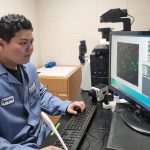Researchers Show that Dorsoventral Polarity Guides Confined Migration of Cancer Cells

Metastasis is a complex process that requires cancer cells to adapt to diverse environments in the body. After they escape from the primary tumor, the cells embark on a long journey to colonize distant organs by migrating through a maze of three-dimensional tracks created by various anatomical structures. Such channels form between adjacent extracellular matrix fibers (collagen), or between nerves, muscles and their connective tissue. These channels represent the highways that cancerous cells use to move efficiently to different parts of the body.
During metastasis, important motor proteins and signaling molecules organize themselves asymmetrically along the front-to-rear cell axis in a phenomenon called cell polarity. This polarity establishes directionality and is essential for persistent cell migration. Although the importance of front-to-rear cell polarity is well understood, it is not known whether metastasizing cancer cells also exhibit dorsoventral polarity, or polarity along their top-to-bottom cell axis.
Dorsoventral polarity orients cells to the geometry of their environment. Once cells sense the geometry around them, they respond by altering their signaling and mode of migration. Emily Wisniewski and Panagiotis Mistriotis, under the direction of Konstantinos Konstantopoulos, along with other colleagues, sought to understand the role that dorsoventral polarity plays in cancer cell migration.
“Previous work has only examined top to bottom cellular asymmetry in non-cancerous, epithelial tissues,” Mistriotis said. “Our studies, performed both in vitro and in vivo, are the first to identify and characterize the important role of dorsoventral polarity during cancer cell migration.”
Wisniewski is a PhD candidate in the Department of Chemical and Biomolecular Engineering at Johns Hopkins, and Mistriotis, is a former postdoctoral fellow at Johns Hopkins and currently an Assistant Professor at Auburn University. Both are from the Institute for NanoBioTechnology (INBT). Konstantopoulos is a professor and core faculty member at the INBT and William H. Schwarz Professor of Chemical and Biomolecular Engineering.
The team discovered that cells’ dorsoventral polarity allows them to distinguish between and respond to different geometries of migration tracks by changing the speed, the mode and/or the mechanism of their locomotion.
In their study, which just appeared in Science Advances, the team, in collaboration with Denis Wirtz, the Theophilus Halley Smoot Professor in the Department of Chemical and Biomolecular Engineering, vice provost for research at Johns Hopkins University, and co-founder and core faculty member at the INBT, Peter Friedl, MD, of MD Anderson Cancer Center, and Giuliano Scarcelli, PhD, of the University of Maryland College Park, compared cancer cell migration in two different geometric environments: channels that were tall and narrow (lateral channels) and channels that were short and wide (vertical channels). The channels had the same cross-sectional area, but distinct aspect ratios and had dimensions similar to confining tracks that cells would normally encounter in the body.

Cells migrating through laterally and vertically confined channels. Scale bar represents 50 μm.
The team observed that cells moved faster in lateral channels than in vertical channels. In the lateral channels, cells migrated with a mesenchymal, or protrusion-based mode, which is classically associated with cell movement on two-dimensional surfaces. In the vertical channels, cells migrated with a bleb-based mode, which look like high pressure bulges or blebs at the cell’s leading and trailing edges.
They were also curious about the involvement of the cell’s nucleus and the RhoA pathways. The nucleus, which is the largest and stiffest cell organelle, sends out important signals to regulate cell migration, and the RhoA pathway plays many functions in cell locomotion. They found that dorsoventrally polarized cells regulate their migration mode and efficiency in response to these different channel geometries by tuning their nuclear stiffness and RhoA activity.
“We demonstrated for the first time that physical confinement stiffens the cell nucleus, which has direct implications on the mechanisms of cell migration,” said Wisniewski.
“This work provides a novel perspective on how the physical cues which are present in the tumor microenvironment regulate distinct mechanisms of cell movement necessary for tumor cell spreading and metastasis,” Konstantopoulos said. “The physical microenvironment contributes to cell plasticity, which may explain why combating cancer metastasis is not an easy feat.”
Story by Emily Wisniewski and Gina Wadas
More Information
You can learn more about this research by reading, “Confinement hinders motility by inducing RhoA-mediated nuclear influx, volume expansion, and blebbing,” by the same authors.





